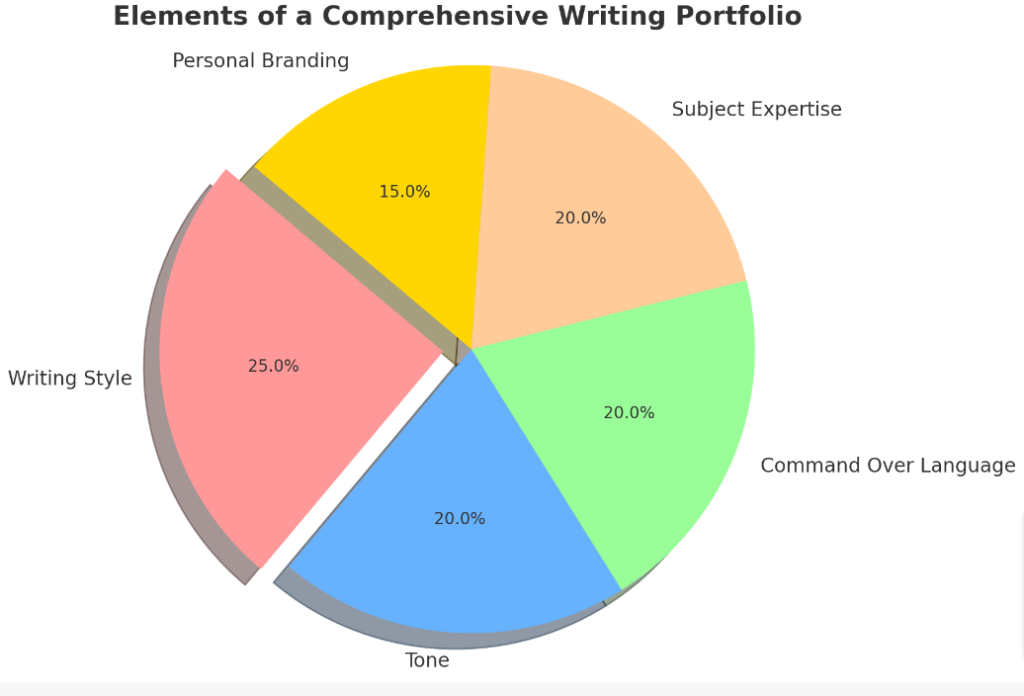Elevating Your Career: The Power of a Professional Writing Portfolio
Thinking about stepping into the realm of freelance writing, but unsure how to display your skill? You’re not alone! Over 56.7 million people in the US have taken their careers down the freelance path.
This article will take you on a tour through why building a dynamic and comprehensive writing portfolio is instrumental and exactly how to create one that sets you apart from others.
Ready to turn your talent into tangible results? Let’s dive right in!
Key Takeaways
- A writing portfolio is crucial for freelance writers to showcase their skills, build credibility with clients, and demonstrate their range and versatility.
- By selecting the best work and organizing it effectively, writers can create a compelling portfolio that highlights their expertise across diverse subjects.
- The portfolio should be continuously updated and improved to stay relevant in the industry and attract potential clients.
The Importance of a Writing Portfolio
A writing portfolio is essential for showcasing your skills, building credibility with clients, and demonstrating your range and versatility.
Showcase your skills and abilities
Presenting a robust writing portfolio allows you to highlight your expertise and talents effectively. Prospective clients can get a feel for your writing style, tone, and command over language through different samples of your work.
You may have worked across diverse subjects or styles; showcasing this range gives potential clients confidence in your versatility. Whether you’ve written blog posts, news articles, white papers or ad copy, ensure each piece reflects the quality of work you can deliver.
By showing off what you’re capable of producing directly speaks about your strengths as a writer without having to explicitly state them. Your portfolio acts like proof of capability which often influences hiring decisions positively.
Build credibility and trust with potential clients
A well-crafted writing portfolio establishes credibility with potential clients. It’s like a professional badge that affirms your writing abilities, showcasing not only your skill but also your commitment to the craft.
Including diverse subjects and styles demonstrates range while polished, error-free samples signal meticulous attention to detail.
Clients need to trust in your capacity to deliver high-quality work consistently. Regularly updating the portfolio can build this trust. Through continuous improvements and addition of recent accomplishments, you let clients view your growth as a writer.
This transparency often translates into increased confidence in your skills over time, influencing potential clients’ decision-making processes favorably.
Demonstrate your range and versatility
Diversifying your writing portfolio is crucial. Expressing capacity in a wide range of genres or industries, from fiction to technical analysis can significantly boost your attractiveness as a writer.
Experiment with various tones, styles, and subjects to display how versatile you are.
Your portfolio should breathe diversity. Don’t limit yourself to one form or genre; include academic papers, blog posts, magazine articles, marketing copy — anything that manifests your ability to adapt and excel in different forms of writing.
This showcases not only your unique style but also the broad extent of your skills and experiences.
How to Create a Writing Portfolio
Choose your best work and organize it effectively to create a compelling writing portfolio that showcases your skills, style, and range.
Select your best work
Choose the cream of the crop when it comes to your writing portfolio. Handpick your finest pieces that truly showcase your skills and abilities. Whether it’s a thought-provoking article, an engaging blog post, or a persuasive sales copy, make sure each selection represents the range and versatility of your writing style.
Remember, quality matters more than quantity in building credibility with potential clients and demonstrating your expertise across diverse subjects. So be selective, choose wisely, and let your best work speak for itself.
Organize and present your work effectively
Organizing and presenting your work effectively in a writing portfolio is crucial for showcasing your skills and grabbing the attention of potential clients. Start by carefully selecting your best pieces that cover a diverse range of subjects to demonstrate your versatility.
Arrange them in a logical order that highlights the different aspects of your writing style and expertise. Use clear headings, subheadings, and labels to make it easy for visitors to navigate through your portfolio.
Additionally, consider using visual elements such as images or infographics to enhance the presentation and make a lasting impression on viewers.
When presenting each piece, provide a brief description that explains its context and purpose. This will help potential clients understand how you approach different topics and projects.
Include specific details about any notable accomplishments or success stories related to each piece, emphasizing how your writing has made a positive impact in various industries or for different clients.
Continuously update and improve your portfolio
To stay relevant and competitive in the writing industry, it’s crucial to continuously update and improve your portfolio. By regularly adding new samples of your work, you can demonstrate that you are actively engaged in your craft and staying up-to-date with current trends and styles.
Updating your portfolio also allows you to showcase any recent accomplishments or projects that highlight your skills and expertise. Moreover, by constantly seeking ways to improve your portfolio, whether through refining existing pieces or creating new ones, you can ensure that it accurately represents your abilities and attracts potential clients.
Using Your Writing Portfolio to Sell Your Skills
Customize your portfolio for specific clients or industries, highlight your accomplishments and success stories, and share it through various channels to effectively sell your writing skills.
Find out how in our latest blog post!
Customize your portfolio for specific clients or industries
Tailor your writing portfolio to cater to the needs of specific clients or industries. This will allow you to showcase samples that are relevant and resonate with your target audience, increasing your chances of landing new projects.
By customizing your portfolio, you can highlight your expertise in a particular niche and demonstrate your understanding of the industry’s unique requirements. This level of personalization shows potential clients that you have the skills and knowledge necessary to meet their specific writing needs.
Highlight your accomplishments and success stories
Highlighting your accomplishments and success stories is a crucial step in selling your writing skills. By showcasing the positive outcomes of your work, you demonstrate to potential clients or employers that you have the abilities they are looking for.
Share instances where your writing has made an impact, whether it’s generating leads, improving conversion rates, or increasing engagement. By emphasizing these achievements, you provide evidence of your expertise and build trust with those considering working with you.
Remember to present these accomplishments in a clear and concise manner, focusing on quantifiable results whenever possible.
Share your portfolio through various channels
Share your writing portfolio with potential clients through a variety of channels to maximize your exposure and increase the chances of securing new opportunities. Utilize social media platforms like LinkedIn and Twitter to showcase your work and connect with professionals in your industry.
Create an online portfolio website where you can display samples of your writing, along with a brief bio and contact information. Submit articles or guest posts to relevant publications or websites to reach a wider audience.
Additionally, consider attending networking events or joining professional writer associations to meet potential clients face-to-face. By sharing your portfolio through various channels, you can expand your reach and attract more clients interested in your skills and expertise in writing.

Conclusion
Having a writing portfolio is essential for selling your skills and standing out in the competitive freelance writing market. Whether you’re showcasing your range of subjects, demonstrating your unique style, or highlighting your accomplishments, a well-curated portfolio can help you attract potential clients and advance your career.
So start building your writing portfolio today and let it speak volumes about your expertise and talent!

